List of Authors
>>About this blog
Recent blog posts
|
[CAM]
18:00 on September 25, 2015
Kafu also rented a house in Chuo-ku, such as Tsukiji, and around Tsukiji and Akashicho often appear.
For example, on September 11, 1921.
"The autumn sky is like a dream. In the afternoon, visiting Yuriko, we went to Fugetsudo to have a dinner, and walked along the coast of Akashicho in the digging. The night view of Tsukuda Island has a taste of copperplate prints. Spread a handkerchief on the stone wall, grip the hand, and talk with the shoulder. As if it were cold and dry, I learned how to cool the collar. Yuriko's heart question is not difficult, but it is difficult to understand. It has a taste of peanut water. You do not have to worry about it. He grabbed his hand again and walked along the waterside, and reached Kasumori Station and separated. Yuriko is allegorized at Tsurumi's Ryotei Kazanso. "
The concise expression of the literary text is wonderful, but in particular, "the taste of peanut flow water" or "do not approach slowly" ...
And there is a woman named Yuriko, "Yuriko's real name is Tomoko" (October 18), but the real name at this time was "Toko Honma", the wife of Masaharu Honma, a Lieutenant General (final rank) who was executed for responsibility for the so-called Bataan Death March after the defeat.
In addition, Kafu and Tomoko deepened their relationship from September to October, and on October 9, "... go to Kagetsu. ・It should be able to finally return to the rain. It is supposed to stay overnight between Yo and Yuriko and each room. ・・ ・ ・ ・ ・ What happened after this is a description of Shiga Tashi, and on October 18, "I will bring a bowl of Yuriko flowers. ・... ", October 19, "I leave around noon Yuriko." On October 20, "... Yurikoyo comes to my house and stays," and on October 21, "I went to Yuriko and Shirakiya to see Western paintings on display. It rains again on the way home. Yuriko Matayo's house, October 24, "Fusame, I'm in the Yuriko family all day," November 5, "Yuriko comes. When we have a dinner at Fugetsudo, stand at Yuuraku-za and return home together, ... "
Knowing that the subsequent "development" and Tomoko divorced Honma on December 16, 1921, the exhilaration of September 11 further deepens its interest.
And even after Tomoko divorced Honma, on December 18, "... Have a dinner at Yuriko and Fugetsudo ...", December 31, "... Along with Yuriko at night, I saw the night koshi of Ginza-dori year-old night ... ", New Year's 9th, 1922, "Yuriko comes in the afternoon", New Year's 17th, "Yuriko visits the house of Hirakawacho" etc. .
[CAM]
18:00 on September 24, 2015
Kankaze describes "Kiyosu Bridge" under construction on April 4, 1927.
"I see the construction of a railway bridge that should cross from the riverbank of Nakashu to Kiyozumi-cho, Fukagawa. Shimbashi was built toward Hamacho, and the road was taken up. In the past, there is a liquor house on the banks of Chushu, and there is a small play called Masago-za on the banks of Mebashi, and there is a Yaba Meizakaya in the alleyway, pulling the sleeves of a mysterious female Gyojin in daytime, After the earthquake, the trace of Masago-za was not easy to ask, and cross the new bridge and take a train at Shinohashi's Kotato and rest in Owaricho Taiga. It was cloudy from Japan and North Korea and Shiga rained, and the wind was getting stronger.'
Construction of Kiyosu Bridge was started in March 1925 as a reconstruction project following the Great Kanto Earthquake (September 1, 1923), and was completed in March 1928. Kankaze wrote that he saw the completed Kiyosu Bridge on April 25, 1928.
"... I went to Kyobashi and went to Chushu Hospital and asked for medicine. From Kayabacho, there is a dust storm in the middle of the water storm, and the muddy car line is disturbed in the muddy muddy, Sechie on the left and right, and it is familiar with the eyes every day, but the city of Tokyo is ugly and ugly. I saw the construction of a new railway bridge over Fukagawa from the Chushu riverbank in Japan already completed ... "
Incidentally, "Tigger" mentioned on April 7 refers to "Tiger" and is a representative cafe in Ginza located at the intersection of Owaricho (Ginza 4-chome). The Tiger was made in 1924. At one time, the store was large enough for 200 women. Kan Kikuchi brought a lot of friends and Bungeishunju Ltd. employees, and he actively drank beer. In "Ginza March" (1928), there is a statement that "I like Tiger Woman Bunshi, and I like Lion Waitress Lady". "Lion" is also a cafe in Ginza that was located at the intersection of Owaricho (Ginza 4-chome), and opened in 1911 by Tsukiji Seiyoken. Café was originally supposed to be a coffee shop, but the character of the cafe at that time was a pure bar. (Saburo Kawamoto, "Kafu and Tokyo": 307)
Current Kiyosu Bridge (photographed on September 23, 2015)
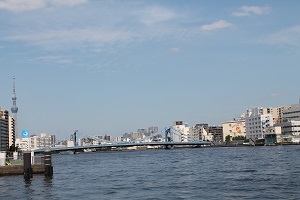
[Sam]
14:00 on September 24, 2015
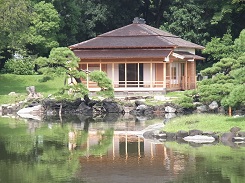 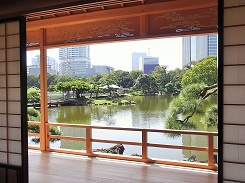
Hamarikyu Onshi Garden, designated as a national special scenic spot and a special historic site, is a valuable heritage that conveys the remnants of Edo's daimyo gardens.
Many buildings and trees in the garden were burned down due to the Great Kanto Earthquake and the war, but from 2004, with the reconstruction of Nakajima Ochiya in 1978, the preservation of cultural property gardens and the next generation In order to pass it on to the next generation, a restoration and maintenance project to faithfully reproduce the design and techniques of the time and bring it back to the present age has started.
In addition to the restoration of aging facilities such as the seawall of Uchibori and Nakano Bridge, the restoration of the Ochiya group, which is an important factor in composing the landscape of the garden.
In 2010, the restoration work of "Matsuno Ochiyaya" was completed.
Next, in May this year, the restoration work of "Tsubame no Ochiya", which had been underway since 2013, was completed, and the inside was recently opened specially.
Initially, it was organized on September 17, 18, and 22 for 3 days, but on both 17 and 18, it was canceled due to rain, and it was released only on the 22nd.
The schedule is from 19:30 to 10:00 2 10:30 to 11:00 3 13:30 to 14:00 4 14:30 to 15:00 in total, 4 times, capacity is limited to 15 people on a first-come, first-served basis.
After listening to the lecture of the garden volunteer guide, such as the outline of the restored "Tsubame no Ochiya" and the history of Hamarikyu Onshi Garden, etc., it is said that the name "Tsubame no Ochiya" was derived from the name "Tsubame no Ochiya", which is not usually seen, It seems that one theory with rabbit ear iris is also transmitted, but the details are unknown), and the interior design, layout, fittings, etc. are carefully watched up close.
And enjoy the view of the large spring water (the pond of tide) from the room, which the shogun, his wife, and court nobles would have tasted for a while.
 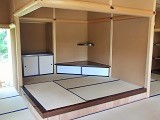 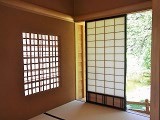
"Tsubame no Ochiya" is an Ochiyaya built during the era of the 11th Shogun Ienari. It seems that the general himself used it as a place for entertaining guests, such as watching furnishings (flower and parlor decoration), eating, and writing waka poems.
<Characteristic designs and techniques of Tsubame Ochiya>
・Upper row in the center of the room
・In the upper part, a triangular bag, a circular shelf board, and a protruding bag
・The northern shelf is a three-stage shelf board that spans two sections.
・All 24 types of nail-covered metal fittings are different in the shape of a swallow.
・A haze pattern design is used for the openwork of the translating board on the edge
・The interior is finished with colored walls (Osaka soil) and the exterior is plastered.
・The roof is made of Japanese Spanish mackerel wood with a thickness of 3 mm.
・shoji door is made of Mino paper and stone wall
I heard that "Hawk Ochiya" is scheduled to be restored by 2017 and "Non Liaokan" by the 2020 Tokyo Olympics.
    
[Nanako Tsukishima]
09:00 on September 24, 2015
 Blessed with fine autumn weather, Silver Week is a perfect day for walking around the city. Blessed with fine autumn weather, Silver Week is a perfect day for walking around the city.
After a long absence, I went to the Harumi Canal and enjoyed the resort feeling nearby.
In fact, it seems that Shin Tsukuda (around Tsukuda 3-chome) flourished as a summer resort overlooking Tokyo Bay at the end of the Meiji era.
At the Kappo cuisine Ryokan, which was built at that time, young writers worked hard to write, and regular guest Toson Shimazaki wrote a newspaper novel "Spring" and Kaoru Osanai wrote "Okawabata".
At present, the concrete wall for seawalls are turned by landfill, and there is no impression of scenic spot. However, the skyscrapers and Skytree of Toyosu on the opposite shore that shines in the autumn sky will delight your eyes fully.
We have also been asked for the Chuo-ku sightseeing test, so we recommend that you extend your legs when walking around Tsukuda and Tsukishima.
[Reference material: Tsukishima Monogatari Inuhiko Yomota]
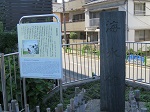 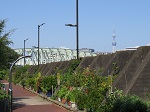 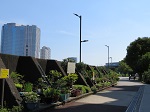
[CAM]
18:00 on September 23, 2015
In 1917, when Kafu started writing "Gyutei Nijo", he lived in a rented house "Muyoan" in Kibiki-cho. However, it is only a double life, it is for the convenience of hospital visits, and it is a big house in Okubo Yochomachi.
On September 20, 1917, "Because I took a walk yesterday, I'm not happy this morning. In the afternoon, he went to a vicious house in Kibiki-cho and waited for the visit of Oishi no kunite. In the first place, this vicious house may only be required to go to the house of Oishi no Kimi Okubo, so I borrowed it to receive a medical examination in the event of a sudden illness. ・... I think of naming a bad house while I can't sleep deeply. At last, I ordered him to be Muyoan."
On December 29, 1917, "Look at Ginza-dori year-round city. There is no place that is different year by year, including the Hagoita store in Shimbashi Domae.'
On October 2, 1918, "It's raining. After a long time, we have enjoyed the morning scenery of Tsukiji and return home after passing Manpo Kibiki-cho."
On October 13, 1918, 'I see Shintomiza with three geisha in Shin-Tomicho'
This Kibiki-cho "Muyoan" was about a year, and then moved to Tsukiji Honganji in December 1918 at 2-30 Tsukiji 2-chome. This time I bought a seller instead of a rented house. He sold out the house of Okubo Yochomachi, which he inherited from his father, and bought it with the money. I moved my family register here, and called me.
On December 22, 1918, "The house behind Tsukiji 2-chome alley is gradually vacant. Taketaya manso, and carry the furniture cabinet."
On December 25, 1918, "Walk in Ginza in the evening. Let the snow come down again. The snow at night behind the alley is not like the wind."
Before and after moving to Tsukiji 2-chome, until the New Year of Taisho 8 (1919), he met frequently with geisha Yaefuku of Shimbashi, and on December 30, 1918, "When I'm going to sleep three more, I elaborated Yae Fuku and the gate, and my life of solitary solitary life ended with the year. It will be so sad to be like joyful.” On the 4th of New Year's Day of Taisho 8 (1919), "It is becoming more and more dense following the day of friendship with Yaefuku. For many years of solitude, it feels comfortable to come in spring suddenly."
However, on the 16th of New Year's Day in 1919, he said, "Invite an old woman in Sakuragi, drop off her geisha Yaefuku, and consult with her in the name of an adopted daughter. ・・ ・ ・ If there is no parent or brother of Geisha Yae Fukuyuki and the nature is extremely mild, if it is appropriate to take care of my illness, I will consult with you a few days ago. In order to identify the woman's identity for the theft of Sakuragi, she is a woman who thinks how to take care of her as a geisha instead of an adoptive woman. People laugh at what they don’t see, and this one is kept secret.” In the description of Yaefuku before and after this, there is a feeling that Kafu fell in love with Yaefuku both physically and mentally, and it is interesting, but it is a little off from the purpose of this article, so unfortunately (laughs) I want to do this about this matter.
[CAM]
18:00 on September 20, 2015
Kizo Kumoto appeared in the Nikkei Shimbun "Leader's Bookshelf" today (September 20, 2015), and lists some works by Kafu Nagai as a favorite reading book. Even if you say Mr. Kumoto, Tokyo may not have a name recognition, but it is Mayor Kambe, a former self-government bureaucrat. I had a few connections and talked a little, so I read it interestingly. It is said that Mr. Kumoto was in contact with the Kafu "Gyutei Nijo" about 20 years ago by a friend of the university, but I have been there since this year.
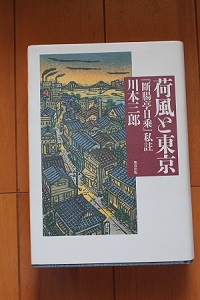
It has been half a century since I first came to Tokyo after entering university, but I did not lose my disgust with the term "Tokyo" and "Edo" and the Kanto dialect, but suddenly I began to feel interest in Edo culture. It was only after this year, and I came to the Chuo-ku sightseeing certification test. Actually, I have been living near Tsukishima Station for more than a dozen years, but when I invited a friend from my university days at the Sumiyoshi-jinja Shirine Main Festival the other day, I ate something called Monjayaki.
Then, lately, I read the works of Kafu Nagai and Junichirou Tanizaki, and finally obtained the complete collection of both individuals. The whole collection is currently trading at an alarming low price in the second-hand market, thankfully for what you buy. However, at the Nihonbashi Library in Chuo-ku, it is funny to say that the complete collection of Tanizaki is treated as valuables.
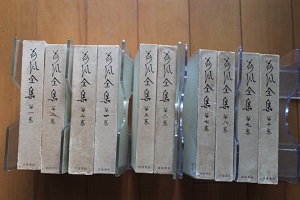 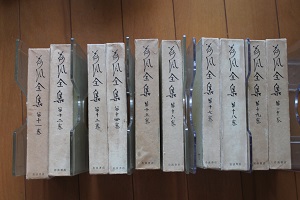 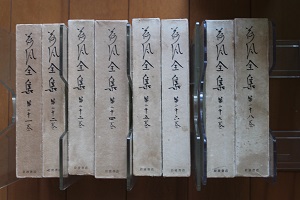 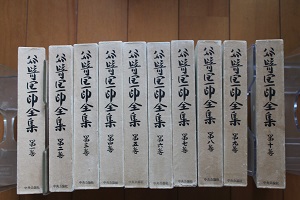 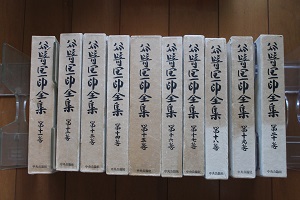 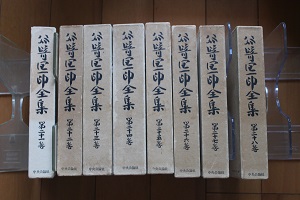
Kafu Nagai's "Gyutei Nijo" is also an abstract of the Iwanami Bunko version, and a complete collection is required to read the full text.
Finally, the heat has gone away, and it will be a great season for a walk for a while. As a poor old man, I would like to take a walk again in Chuo-ku, Tokyo with the feeling of a little wind while placing the Kafu "Gyutei Nijo", "Hyowa Geta", and Tanizaki's "Childhood" on the right. Where you are.
|
Links
|











